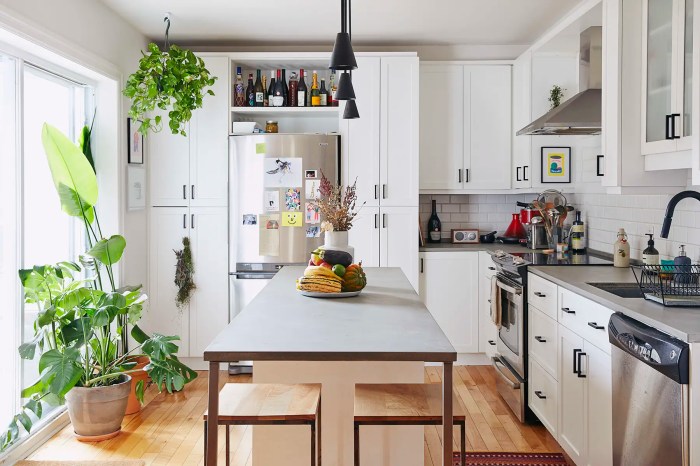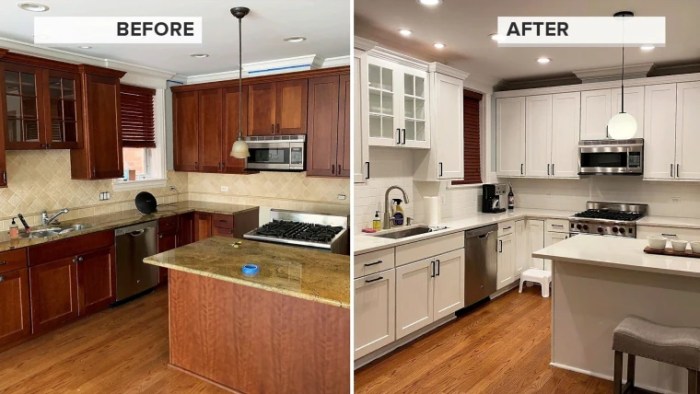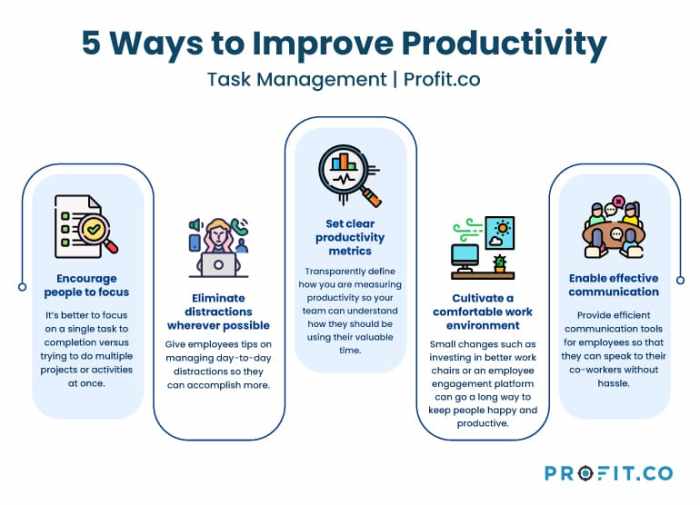
Transforming your kitchen into a stylish and functional space doesn’t have to break the bank. With a little creativity and effort, you can achieve a dramatic makeover without emptying your wallet. This guide explores a range of affordable home improvement projects that can elevate your kitchen’s aesthetics and functionality, making it a more enjoyable and inviting space for cooking, dining, and gathering.
From revamping your cabinets and countertops to adding stylish backsplashes and enhancing lighting, we’ll cover practical tips and techniques to help you achieve your desired kitchen transformation. We’ll also discuss the importance of efficient storage solutions and how to create a kitchen layout that maximizes functionality and flow.
Revamping Your Kitchen Cabinets

Giving your kitchen cabinets a makeover can dramatically change the look and feel of your entire space. Whether you’re looking for a fresh, modern aesthetic or a cozy, traditional vibe, refinishing or replacing your cabinets can be a rewarding project.
Refinishing Kitchen Cabinets with Paint or Stain
Refinishing your cabinets is a cost-effective way to give your kitchen a fresh look. You can achieve a completely new style with paint or stain, depending on the desired effect.
- Preparing the Cabinets: Start by cleaning your cabinets thoroughly with a degreaser to remove any grease or grime. Sand the surfaces lightly to create a smooth, even base for the paint or stain.
- Choosing Paint or Stain: Consider the existing color of your cabinets, the style of your kitchen, and your personal preferences.
- Paint: Choose a high-quality paint specifically designed for cabinets, as it will be more durable and resist chipping.
- Stain: Stain is a great option if you want to enhance the natural wood grain of your cabinets. Select a stain color that complements your kitchen’s overall design.
- Applying Paint or Stain: Use a high-quality brush or roller to apply the paint or stain evenly. Allow each coat to dry completely before applying the next.
- Finishing Touches: Once the paint or stain is dry, apply a sealant to protect the finish and make it easier to clean. You can also add hardware, such as knobs or pulls, to complete the look.
Replacing Cabinet Hardware
Replacing cabinet hardware is a simple and affordable way to instantly upgrade your kitchen’s look.
- Choosing Hardware: Consider the style of your kitchen and your personal preferences when selecting new hardware.
- Modern: Sleek, minimalist hardware with clean lines.
- Traditional: Ornate, detailed hardware with a classic feel.
- Rustic: Hardware made from natural materials like wood or metal.
- Measuring and Ordering: Measure the existing hardware to ensure you order the correct size and style.
- Installation: Most cabinet hardware comes with instructions for installation. Use a screwdriver or drill to attach the new hardware.
Comparing Cabinet Replacement Costs with Refinishing
| Replacing Cabinets | Refinishing Cabinets | |
|---|---|---|
| Cost | $5,000 – $15,000 or more, depending on the size of the kitchen and the type of cabinets. | $500 – $2,000, depending on the size of the kitchen, the type of paint or stain used, and the amount of labor involved. |
| Time | Several weeks, depending on the complexity of the project and the availability of contractors. | A few days to a week, depending on the size of the kitchen and the number of cabinets. |
| Effort | Requires professional installation and significant disruption to the kitchen. | Can be a DIY project, although professional help may be needed for large kitchens or complex projects. |
Installing New Cabinet Doors
Replacing your cabinet doors can give your kitchen a completely new look without having to replace the entire cabinet system.
- Choosing New Doors: Consider the style of your kitchen, your budget, and the desired look.
- Measuring Existing Doors: Measure the width, height, and thickness of your existing cabinet doors to ensure you order the correct size.
- Installing the New Doors: Remove the existing doors, attach the new doors to the cabinet boxes using hinges, and install new hardware.
Upgrading Countertops
Replacing your countertops is a great way to refresh your kitchen’s look and feel. Countertops are a major focal point, so choosing the right material is important. You can find a wide variety of options, from budget-friendly laminate to high-end quartz.
Countertop Materials
Choosing the right countertop material for your kitchen depends on your budget, style preferences, and how much maintenance you’re willing to do. Here’s a comparison of some popular options:
- Laminate: Laminate is the most affordable countertop option, and it comes in a wide variety of colors and patterns to match any style. It’s also easy to clean and maintain. However, laminate can be easily scratched and damaged, and it’s not as durable as other materials.
- Butcher Block: Butcher block countertops are made from wood, usually maple or walnut. They’re known for their durability, warmth, and natural beauty. Butcher block is also easy to repair if it gets scratched or damaged. However, it requires regular sealing and maintenance to prevent stains and water damage.
- Quartz: Quartz countertops are made from crushed quartz mixed with resin. They’re very durable, scratch-resistant, and stain-resistant. Quartz comes in a wide range of colors and patterns, including those that mimic natural stone. However, quartz is more expensive than laminate or butcher block.
Installing Laminate Countertops
Laminate countertops are relatively easy to install, making them a popular DIY project. Here’s a basic guide:
- Measure and cut the laminate. Measure the countertop area carefully and cut the laminate to size using a circular saw with a fine-tooth blade. Be sure to make the cuts precise to ensure a clean, even fit.
- Prepare the countertop base. Clean the countertop base thoroughly to remove any dirt or debris. Apply a layer of adhesive to the base and allow it to dry slightly.
- Install the laminate. Carefully place the laminate on the countertop base, aligning it with the edges. Use a roller to press the laminate firmly into place, ensuring that it’s adhered to the base.
- Trim and seal the edges. Use a trim tool to cut the laminate around the sink and other fixtures. Apply sealant to the edges of the laminate to prevent water damage.
Sealing and Maintaining Countertops
Regular sealing and maintenance are crucial for keeping your countertops looking their best and extending their lifespan. The specific methods for sealing and maintaining countertops vary depending on the material:
- Laminate: Laminate countertops don’t require sealing, but they should be cleaned regularly with a mild soap and water solution. Avoid using abrasive cleaners or scouring pads, as these can scratch the surface.
- Butcher Block: Butcher block countertops should be sealed with a food-safe mineral oil or butcher block conditioner every few months. The sealant helps to protect the wood from stains and water damage. Clean butcher block countertops with a damp cloth and mild soap. Avoid using harsh chemicals or cleaners.
- Quartz: Quartz countertops are non-porous and don’t require sealing. They’re also very easy to clean with a mild soap and water solution. Avoid using abrasive cleaners or scouring pads, as these can scratch the surface.
Installing a New Countertop Sink
Installing a new countertop sink is a fairly straightforward process, but it’s important to follow the manufacturer’s instructions carefully. Here’s a general guide:
- Prepare the countertop. Measure and cut the countertop opening for the sink using a jigsaw or a circular saw with a fine-tooth blade. Be sure to make the cut precise to ensure a clean, even fit.
- Install the sink base. Place the sink base in the countertop opening and secure it using the provided mounting clips or screws.
- Connect the plumbing. Connect the sink drain to the drainpipe and the faucet to the water supply lines. Be sure to use the correct fittings and sealants.
- Test the sink. Turn on the water supply and check for leaks. If everything is working properly, you’re ready to enjoy your new countertop sink.
Creating a Focal Point with Backsplashes
A backsplash is a practical and stylish addition to any kitchen. It protects the wall behind your countertops from splashes and stains, while also adding a decorative touch. With a wide variety of materials and design options available, you can easily find a backsplash that complements your kitchen’s style and budget.
Backsplash Material Options
There are several different materials you can use for your backsplash, each with its own unique characteristics. Here are some popular choices:
- Tile: Tile is a popular backsplash material because it’s durable, easy to clean, and comes in a wide variety of styles and colors. Ceramic tile is the most affordable option, while porcelain tile is more durable and water-resistant. Natural stone tiles, such as granite, marble, and slate, offer a more luxurious look but can be more expensive.
- Glass: Glass backsplashes are a modern and stylish option that can add a touch of elegance to your kitchen. They are also easy to clean and come in a variety of colors and finishes. Glass tiles are a popular choice for backsplashes, but you can also find larger sheets of glass that can be installed as a single piece.
- Metal: Metal backsplashes are a durable and stylish option that can add a modern or industrial feel to your kitchen. Stainless steel is a popular choice for metal backsplashes, but you can also find backsplashes made from copper, brass, or aluminum.
Designing a Visually Appealing Backsplash
Here are some tips for creating a visually appealing backsplash design:
- Consider the size of your kitchen. A large backsplash can make a small kitchen feel even smaller, so it’s important to choose a design that’s proportional to the space. In a small kitchen, you may want to consider a simple design with a light color.
- Choose a color scheme that complements your kitchen’s overall style. If your kitchen has a modern style, you may want to choose a backsplash with clean lines and a neutral color. If your kitchen has a more traditional style, you may want to choose a backsplash with intricate patterns and a warm color.
- Add texture to your backsplash. A textured backsplash can add visual interest to your kitchen. You can choose tiles with different shapes, sizes, or finishes, or you can use a combination of different materials.
- Incorporate a focal point. A focal point can be a decorative tile, a unique pattern, or a piece of art. A focal point can draw the eye to a specific area of the kitchen and create a sense of balance.
Cost and Installation of Backsplash Materials
| Material | Cost per square foot | Installation Process ||—|—|—|| Ceramic tile | $5 – $15 | Relatively easy to install, but requires some experience with tiling. || Porcelain tile | $10 – $30 | Similar to ceramic tile installation, but requires more care due to its durability. || Natural stone tile | $20 – $100 | Requires professional installation due to its weight and delicate nature.
|| Glass tile | $15 – $50 | Relatively easy to install, but requires precision and care. || Glass sheet | $30 – $100 | Requires professional installation due to its size and weight. || Stainless steel | $20 – $50 | Relatively easy to install, but requires some experience with metalworking. || Copper | $40 – $100 | Requires professional installation due to its delicate nature.
|| Brass | $30 – $70 | Requires professional installation due to its delicate nature. || Aluminum | $10 – $30 | Relatively easy to install, but requires some experience with metalworking. |
Installing a Backsplash
Here is a step-by-step guide on how to install a backsplash:
- Prepare the wall. Clean the wall thoroughly and remove any existing wallpaper or paint. If necessary, apply a layer of primer to help the backsplash adhere to the wall.
- Measure and mark the area for the backsplash. Use a level to ensure that the lines are straight.
- Install the backsplash. The installation process will vary depending on the type of backsplash you choose. For tile backsplashes, you will need to use mortar to adhere the tiles to the wall. For glass or metal backsplashes, you may need to use adhesive or screws.
- Grout the tiles. Once the backsplash is installed, you will need to grout the tiles to fill in the gaps between them. Use a grout float to spread the grout evenly and wipe away any excess grout with a damp sponge.
- Seal the grout. Sealing the grout will help to protect it from stains and water damage. Use a grout sealer that is specifically designed for the type of grout you used.
Enhancing Lighting
Good lighting is crucial for any kitchen, as it can significantly impact the overall ambiance and functionality of the space. Well-lit kitchens feel more inviting and make it easier to prepare meals, while poorly lit kitchens can create a gloomy and unwelcoming atmosphere.
Selecting the Right Lighting Fixtures
Choosing the right lighting fixtures for your kitchen is essential for achieving the desired look and functionality. Different areas of the kitchen require different types of lighting.
- Task Lighting: Under-cabinet lighting is perfect for task lighting, providing focused illumination on countertops and work areas. It helps with food preparation, chopping, and cleaning tasks.
- Ambient Lighting: Overhead lighting, such as recessed lights or pendant lights, provides general illumination for the entire kitchen. This type of lighting sets the mood and creates a warm and inviting atmosphere.
- Accent Lighting: Accent lighting highlights specific features in the kitchen, such as artwork, cabinets, or architectural details. It adds visual interest and depth to the space.
Installing Under-Cabinet Lighting
Installing under-cabinet lighting is a relatively simple DIY project that can significantly improve the functionality of your kitchen.
- Choose the Right Type of Lighting: LED strip lights are a popular choice for under-cabinet lighting due to their energy efficiency and long lifespan. They come in various colors and brightness levels, allowing you to customize the look and feel of your kitchen.
- Measure and Mark the Installation Area: Measure the length of your cabinets and mark the location where you want to install the lights. Make sure to leave enough space for the power cord.
- Install the Mounting Strips: Attach the adhesive mounting strips to the underside of your cabinets, ensuring they are level and secure.
- Connect the Lights: Connect the LED strip lights to the power source, following the manufacturer’s instructions. You can use a plug-in adapter or hardwire the lights directly to your electrical system.
- Test and Enjoy: Once the lights are installed, test them to ensure they are working correctly. Adjust the brightness and color settings as needed to achieve your desired look.
Comparing Lighting Options
Here’s a table comparing the cost and energy efficiency of different lighting options:
| Lighting Type | Cost | Energy Efficiency |
|---|---|---|
| Incandescent Bulbs | Low | Low |
| Halogen Bulbs | Moderate | Moderate |
| Fluorescent Bulbs | Moderate | High |
| LED Bulbs | High | Very High |
Adding Storage Solutions
A well-organized kitchen is a joy to work in. Efficient storage not only keeps your kitchen clutter-free but also makes cooking and cleaning more convenient. By maximizing your storage space, you can create a functional and aesthetically pleasing kitchen without breaking the bank.
Maximizing Storage Space with Shelves, Organizers, and Drawers
Shelves, organizers, and drawers are versatile storage solutions that can transform your kitchen. Open shelves are a budget-friendly option for showcasing your favorite dishes and cookware while adding a touch of rustic charm.
Open shelves can be a cost-effective way to create additional storage in your kitchen. They can also be used to display your favorite kitchen items, making them a decorative element.
For efficient organization, consider using drawer organizers to separate utensils, spices, and other items. These organizers create dedicated compartments, ensuring everything has its place and is easily accessible.
Drawer organizers can help you keep your kitchen drawers organized and tidy. They are also a great way to maximize the space in your drawers.
Organizing Kitchen Utensils and Appliances
With a variety of kitchen utensils and appliances, it’s crucial to organize them effectively. Utilize drawer dividers to separate your knives, spoons, and other utensils, preventing them from cluttering up your drawers.
Drawer dividers can help you organize your kitchen utensils and keep them from getting mixed up. They are also a great way to keep your drawers looking neat and tidy.
Consider using tiered turntables for storing spices, oils, and other frequently used items in your pantry or cabinets. These turntables maximize vertical space, allowing you to access everything without having to move items around.
Tiered turntables can help you maximize the space in your pantry or cabinets. They are also a great way to keep your frequently used items within easy reach.
Cost and Functionality of Different Storage Solutions
| Storage Solution | Cost | Functionality |
|---|---|---|
| Open Shelves | Low | Versatile, budget-friendly, can be used for display |
| Drawer Organizers | Moderate | Maximizes drawer space, keeps items organized |
| Tiered Turntables | Moderate | Maximizes vertical space, easy access to items |
| Pull-Out Pantry Systems | High | Provides ample storage space, easy access to items |
Improving Functionality
A well-designed kitchen layout is crucial for maximizing efficiency and enjoyment. By optimizing the flow of movement and creating designated zones for specific tasks, you can make your kitchen a more functional and enjoyable space.
Optimizing Kitchen Layout
A well-planned kitchen layout promotes a smooth workflow, minimizing wasted steps and maximizing efficiency. The most common and effective layout is the work triangle, which involves placing the sink, refrigerator, and stove in a triangular formation.
- The Work Triangle: The ideal distance between each point of the triangle should be between 4 and 6 feet. This allows for sufficient space to move around comfortably without feeling cramped.
- Consider Your Needs: Think about how you use your kitchen. Do you frequently entertain? Do you need a lot of counter space? Do you have a small family or a large one? Answering these questions will help you decide on the layout that best suits your lifestyle.
Adding Features
Adding features like a kitchen island or a pantry can significantly enhance the functionality of your kitchen.
- Kitchen Islands: Kitchen islands provide additional counter space, storage, and a central gathering spot. They are a great way to add functionality and style to your kitchen.
- Pantries: Pantries offer ample storage space for groceries, cookware, and other kitchen essentials. They can be walk-in or built-in, depending on the available space.
Comparing Kitchen Layouts
| Layout | Cost | Benefits ||—|—|—|| Galley Kitchen | Low | Efficient, compact, maximizes space, ideal for smaller kitchens || L-Shaped Kitchen | Moderate | Versatile, offers ample counter and cabinet space, allows for a work triangle || U-Shaped Kitchen | High | Offers maximum storage and counter space, creates a defined work area, ideal for larger kitchens || G-Shaped Kitchen | High | Similar to U-shaped, but with a peninsula, provides additional counter space and seating || Open-Concept Kitchen | Moderate to High | Creates a sense of spaciousness, combines kitchen with living areas, ideal for entertaining |
Home Improvement Straw

A home improvement straw, also known as a flexible straw or a drywall straw, is a versatile tool used for various home improvement projects. It’s a long, flexible tube made from durable plastic, typically ranging from 1/4″ to 1/2″ in diameter.
Uses of a Home Improvement Straw
The straw’s flexibility and durability make it ideal for a range of tasks. Here are some of its most common applications:
- Applying Adhesive and Sealant: The straw’s narrow tip allows for precise application of adhesives and sealants in hard-to-reach areas, like corners, gaps, and crevices. This helps avoid messy spills and ensures even distribution.
- Transferring Liquids: The straw’s long length makes it perfect for transferring liquids from one container to another, especially for those that are difficult to pour. This is useful for transferring paint, varnish, or other viscous liquids.
- Cleaning and Clearing: The straw can be used to clean out small spaces and crevices that are difficult to reach with traditional cleaning tools. This includes cleaning out gutters, pipes, and air vents.
- Creating a Template: You can use a straw to create a template for cutting shapes or patterns. For example, you can use a straw to create a template for cutting a circular hole in drywall or wood.
Advantages of Using a Home Improvement Straw
- Versatility: The straw’s flexibility and durability make it suitable for a wide range of tasks.
- Precision: The straw’s narrow tip allows for precise application of materials, reducing waste and mess.
- Accessibility: The straw’s long length makes it ideal for reaching hard-to-reach areas.
- Cost-Effective: Home improvement straws are inexpensive and readily available.
Disadvantages of Using a Home Improvement Straw
- Limited Durability: While durable, the straw can be prone to bending or breaking if used improperly.
- Limited Size: The straw’s narrow diameter may not be suitable for all applications.
- Cleaning Challenges: Cleaning the straw thoroughly after use can be challenging, especially if used with viscous materials.
Types of Home Improvement Straws
A table comparing different types of home improvement straws and their applications is provided below:
| Type | Diameter | Material | Applications |
|---|---|---|---|
| Standard | 1/4″ | Polyethylene | Applying adhesives, sealants, and transferring liquids |
| Heavy-Duty | 1/2″ | Polypropylene | Cleaning gutters, pipes, and air vents |
| Flexible | 1/4″ | PVC | Creating templates, applying adhesives, and transferring liquids |
By implementing these affordable kitchen improvement ideas, you can create a space that reflects your personal style and enhances your daily life. Remember, even small changes can make a big difference. Embrace the opportunity to personalize your kitchen, and enjoy the process of transforming it into a haven that you love.
Common Queries
What are some essential tools for affordable kitchen upgrades?
Essential tools include a measuring tape, level, screwdriver, drill, paintbrushes, sandpaper, and a utility knife. You may also need specialized tools depending on your specific projects, such as a tile cutter or a countertop template.
How can I find affordable materials for my kitchen upgrades?
Look for deals at home improvement stores, online retailers, and secondhand shops. Consider using salvaged or repurposed materials for unique and budget-friendly solutions. You can also try DIY projects using readily available materials like paint, wallpaper, or contact paper.
Can I upgrade my kitchen without hiring a professional?
Many kitchen upgrade projects can be tackled by homeowners with basic DIY skills. However, for complex tasks like installing new countertops or plumbing, it’s advisable to consult with a professional to ensure safety and proper execution.




